[custom_headline type=”left” level=”h1″ looks_like=”h2″]POSEIDON[/custom_headline]
In Situ Poseidon Liquid Flow TEM Holder
LIQUID AND ELECTRO CHEMICAL CONTROL WITHIN THE MICROSCOPE
Poseidon™ allows scientists and engineers to image materials and biological samples in a self-contained and fully hydrated flowing and mixing chamber, directly within the TEM.
Brochure Poséidon Select (27 downloads )Flexible Imaging Condition
Samples and processes that previously required freezing or could not be imaged in their native operating environment can now be studied and observed in liquid and at high resolutions.
From hydrated materials such as inks and gels, to biological materials including whole cells Poseidon allows you to quickly and easily load samples in a sealed environment and image within the TEM.
With the Poseidon Select electrochemistry system, you can combine these features with the power to characterize electrochemical reactions in real-time.
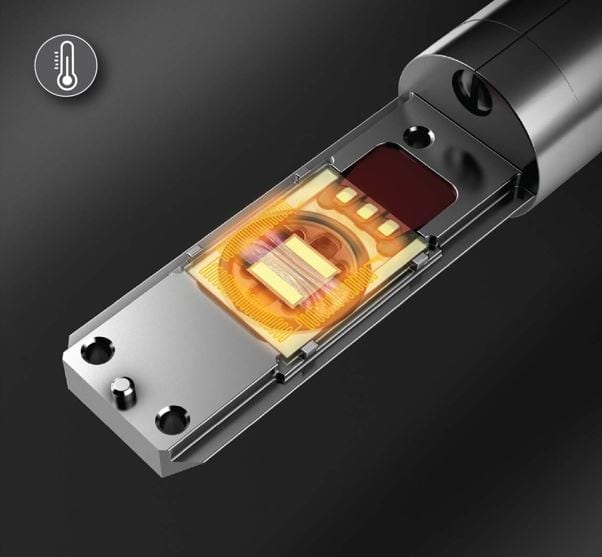
Poséidon Select electrochemistry system
Poseidon Select enables scientists, engineers, and product developers to observe and characterize electrochemical reactions at the nanometer scale, in realistic reaction environments, in real-time. Poseidon Select shrinks the typical electrochemical lab to the size of a microchip, which can be safely inserted into a transmission electron microscope (TEM). This microfluidic electrochemical cell enables researchers to view electrochemical reactions at high resolution while simultaneously performing cyclic voltammetry and other electrochemical experiments. By using the Poseidon Select, scientists can explore the fundamental physical properties of materials and optimize electrochemical systems such as batteries, fuel cells, chemical production, and anti-corrosive surface coatings.
The Protochips Poseidon Select is the only third party in situ electrochemical system on the market to have been certified by FEI, JEOL and Hitachi as safe for use in their instruments. Use of Poseidon Select will not violate your warranty or service plan with those instruments.
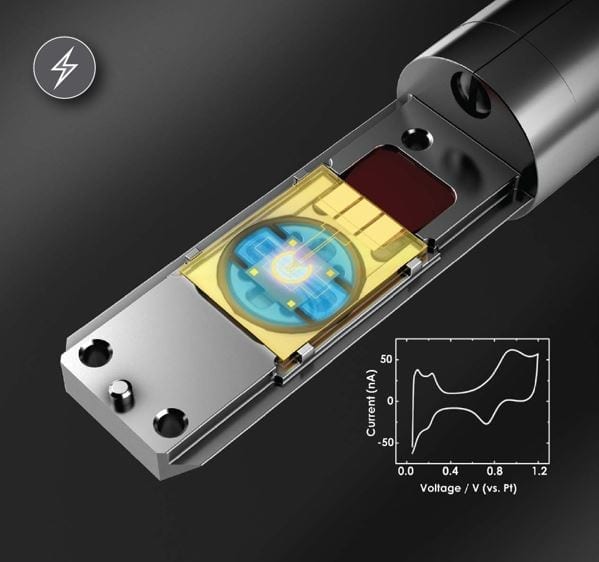
Avec l’utilisation du Poséidon Select, les scientifiques peuvent combiner simultanément l’imagerie haute résolution avec la puissance de l’analyse électrochimique quantitative pour révéler les propriétés fondamentales des matériaux comme les batteries, les piles à combustible, les productions chimiques ou encore les traitements de revêtement anti-corrosions.
Dans le cadre d’études en « science du vivant », on trouve aussi de nombreuses nouvelles applications innovantes comme l’étude de cinétique de transfert, l’étude d’activités enzymatiques, ou encore l’analyse quantitative des effets tunnel/électron entre électrodes et protéines.
Le Poséidon Select utilise des supports Echips Silicium apairés avec une fenêtre en SiN afin de créer un environnement liquide étanche protège l’échantillon au sein d’un microscope TEM sous vide poussé.
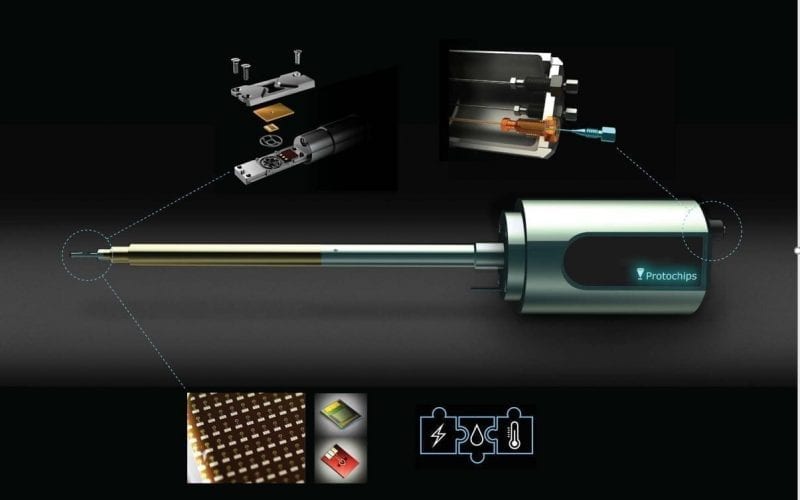
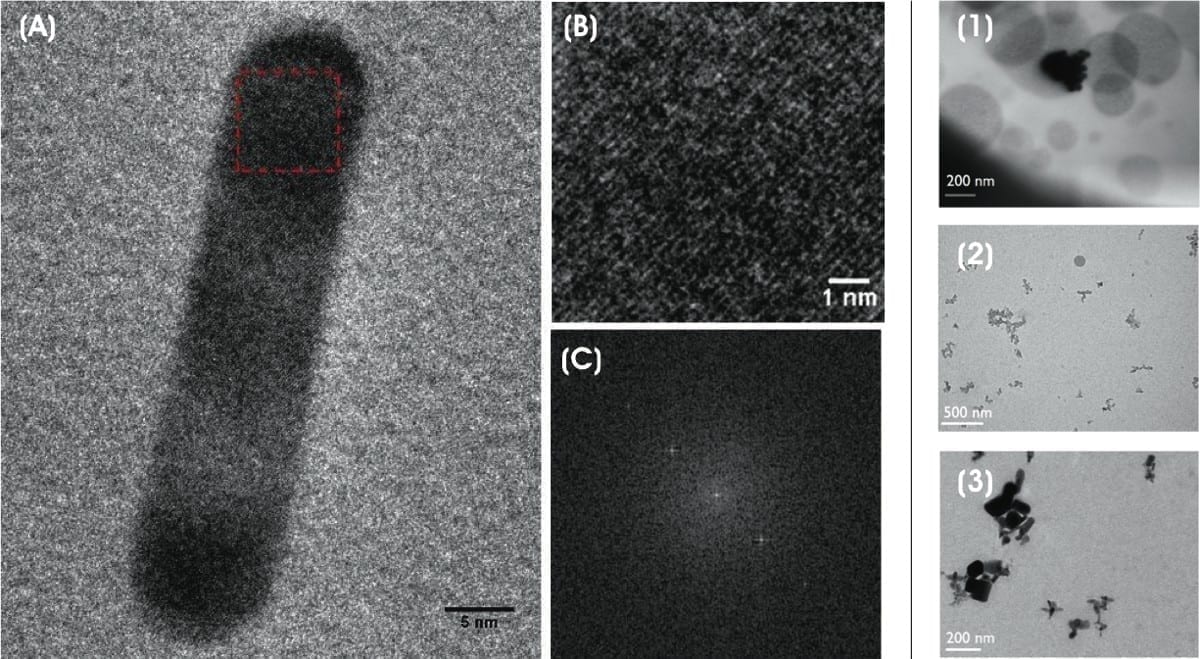
High Resolution and Dynamic Imaging
Left pictures –Gold nanorod imaged in 150 nm of liquid using Protochips’ Poseidon liquid in situ system.
(A) NGold nanorod
(B) Detail of the 200 lattice plane spacing
(C) FFT showing 2 angstrom resolution
Right pictures
(1) Skin Cream
(2) Printer Ink (Diluted to 3%)
(3) Sunblock
Key benefits
- Flexible – Poseidon enables samples to be imaged under native, hydrated conditions without modifying the user’s microscope.
- Dynamic – With the ability to flow sample or solvent using a 2-port system and to introduce additional reagents with a 3-port system, Poseidon allows the user to dynamically modify the environment during imaging.
- Efficient – Poseidon does not require the sample to be dried or frozen prior to imaging, thus preparation time is reduced and drying artifacts are avoided.
- Comprehensive – The Poseidon platform comes complete with all the components and support necessary for successful in situ experiments.
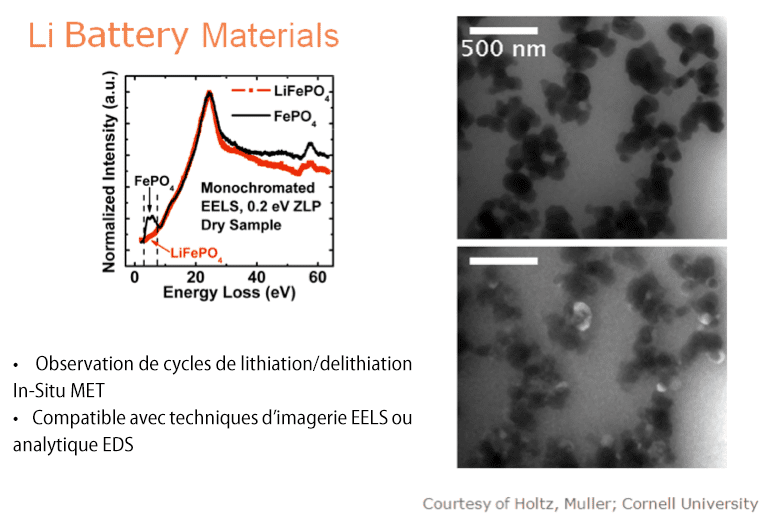
Poseidon Select – Lithium dendrite formation
Scientists at the Department of Energy’s Oak Ridge National Laboratory have captured the first real-time nanoscale images of lithium dendrite structures known to degrade lithium-ion batteries. The ORNL team’s electron microscopy could help researchers address long-standing issues related to battery performance and safety.
Video shows annular dark-field scanning transmission electron microscopy imaging (ADF STEM) of lithium dendrite nucleation and growth from a glassy carbon working electrode and within a 1.2M LiPF6 EC:DM battery electrolyte.
The Poseidon platform enables observation of dynamic processes in situ. This movie shows the formation of salt crystals from a saturated solution of phosphate buffered saline. Images were acquired at a rate of 1 frame per second and are shown at 5 times real speed. 500 nm liquid thickness. Images collected using a Philips/FEI CM300FEG TEM at 300 kV. Courtesy of Dr. Kate Klein, National Institute of Standards and Technology.
A mixture of spherical gold nanoparticles and gold nanorods suspended in water was imaged using the Protochips’ Poseidon in situ liquid holder. The gold nanoparticles are highly mobile and can be observed moving and linking together over time. A 150 nm spacer configuration was used and the imaging acceleration voltage was 200 kV.
This movie shows a series of images that demonstrates the tilt range of Poseidon. Images of aggregated 30 nm gold nanoparticles in 1.5 μm of water were collected in 5° increments, over a total angle of -30° to +30°. Data was collected using a Philips/FEI CM300FEG TEM equipped with a GIF energy filter at 300 kV.
30 nm gold nanoparticles attracted to the electron beam in a liquid thickness of 150 nm. Images collected using a Philips/FEI CM300FEG TEM at 300 kV. Courtesy of Dr. Kate Klein, National Institute of Standards and Technology.
Electron beam-induced growth of calcite nanoparticles in situ in the presence of AP7, a nacre protein that is found in abalone shellfish. The calcite particles were grown in the spatially confined conditions of the in-situ liquid cell in a liquid layer of 500 nm. During growth both a stable protein mediated scaffold-type structure, and an unstable crystalline structure which re-dissolved shortly after formation, were observed. (JEOL JEM-2200 FS with double Cs correction, operated at 200 KV in STEM mode. Movie playback is increased by a factor of 25). Courtesy of Andreas Verch and Roland Kroeger.
Electron beam induced growth of lead nanoparticles from a 40 mM aqueous solution of Pb(NO3)2. Nucleation was induced by the electron beam, and the particles grow via an Oswaldt ripening process followed by second growth stage in which the particles increase uniformly in size. The Oswaldt ripening process is indicated by the red circle. When these nanoparticles are in close proximity to larger nanoparticles, they decrease in size and ultimately disappear, while larger nanoparticles increase in size.
The movie was recorded using FEI Tecnai Biotwin operated at 120 KV and is courtesy of Dr. Albert D. Dukes, III, Lander University and Dr. Deborah Kelly, Virginia Tech.
DOWNLOAD DEPOSITION METHODS
APPLICATION NOTES
POSEIDON Select
POSEIDON Select with electrochemical package

